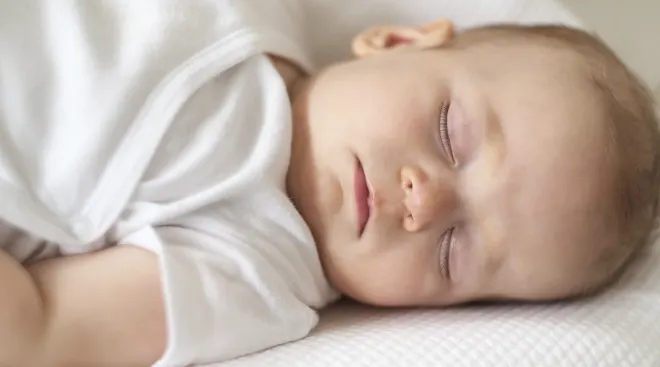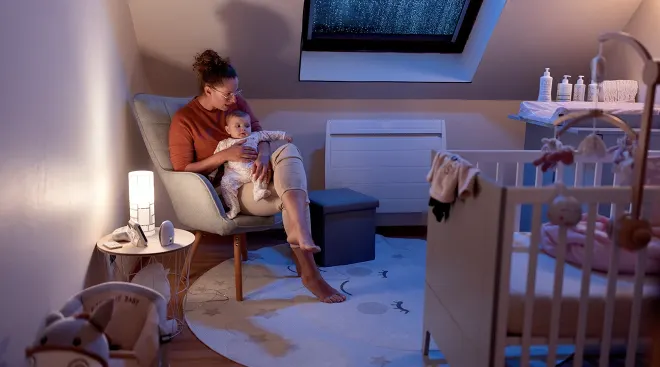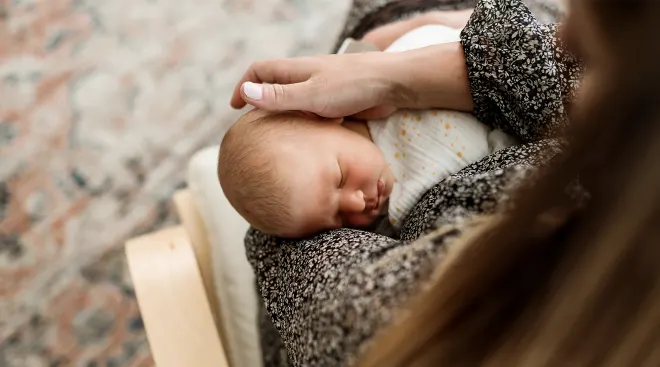Expert Advice for Baby Sleep Problems
For many parents, getting baby to sleep is like cracking a code. Harvey Karp, MD, is not one of those parents. The renowned pediatrician and creator of the Happiest Baby on the Block program is taking the mystery out of sleep solutions, explaining that in general, any sense mystery is the result of misinformation among parents.
“There’s a giant myth perpetrated by doctors that there’s nothing you can do to improve a baby’s sleep,” Dr. Karp tells The Bump. “People recommend the cry-it-out method because they don’t know what else to do.”
Dr. Karp says there is plenty you can do beyond his trademark “5 S’s” (swaddling, side or stomach position, shushing, swinging and sucking) to soothe babies and help them (and yourself!) get an appropriate amount of sleep.
Create the perfect sleeping environment
The ideal sleeping temperature for baby is right around 70 degrees. And baby will give you cues if he or she is too hot or cold.
“Feel their ears, do they feel too cold? Or their neck; is it sweaty?” Asks Dr. Karp. If the answer to either is yes, you can add or remove layers of clothing as needed.
Especially after a Daylight Saving time change, nursery lighting becomes especially important as well. Dr. Karp suggests doing anything you can to darken the space, helping create the illusion of nighttime.
Introduce white noise
“After nine months surrounded by sound, why take that away from them?” asks Dr. Karp, explaining that the womb is anything but silent. “White noise is a familiar and comforting sound. And as babies get older and more aware of their surroundings, it helps cover distractions like planes, trains and even their own sounds.”
White noise is a helpful tool throughout the entirety of baby’s first year. But all white noise is not created equal.
“There are two different types of white noise that have completely opposite effects,” says Dr. Karp. “High-pitched sounds are great for getting attention and calming crying. But low-pitched rumbles are what help get baby to sleep. With this in mind, Happiest Baby created specially-engineered sounds for parents to use.”
Perfect your swaddling technique
Swaddling + white noise = the ideal formula for sleep. Dr. Karp indicates that parents should implement both for baby’s first four months, and extend white noise through the first year.
While practice makes perfect when it comes to swaddling, Dr. Karp says different types of sleep sacks can do the trick if your wrapping and tucking skills aren’t up to snuff.
“There’s all different blankets available. One brand, Little Lotus, helps to regulate a baby’s temperature, which is something that can disturb baby’ sleep. Merlin’s Magic Sleepsuit immobilizes a child’s arms to keep them from startling themselves, but it can also prevent them from sucking their fingers and self-soothing.”
Give sleep-training a go
“The key to sleep training is to do it in a way that’s reassuring without being overly reassuring,” says Dr. Karp, indicating a good starting point is right around the four month mark. “Ultimately, no one feels good about letting baby cry it out.”
Dr. Karp says a better approach is called Up and Down, in which parents place baby in the crib while still awake and leave the room if there’s no fussing. If baby begins to cry and is unable to self-soothe back to sleep, parents come in, pick the child up for a few minutes, and place them back in the crib. Repeat the process until baby eventually falls asleep in the crib.
Teach baby to sleep in the crib or bassinet
When all else fails, many parents get in the habit of nursing or rocking their babies to sleep. The downside? Baby might have trouble falling asleep anywhere but your arms. Dr. Karp says there’s an easy fix.
“A common myth that leads to sleep problems is that you should never wake a sleeping baby,” he says. “Actually, you should always wake a sleeping baby. We can’t tell people not to rock their babies to sleep; it’s natural and beautiful. If they’re falling asleep in your arms, wake them up a little bit as you slide them into the bassinet. They’ll look around and then fall back asleep.”
The rationale here is that baby will become aware of his or her surroundings before dozing back off. The bassinet or crib will become familiar sleep environment.
Check out The Bump’s Sleep Training Infographic:
Know the risks of co-sleeping
As baby does become acclimated to the bassinet or crib, remind yourself that’s the safest place for them to snooze.
“Most moms end up sleeping with their babies at some point or another, and it’s a high-risk situation,” says Dr. Karp, warning against bedsharing. “When you have a young baby at home, you’re averaging six hours of sleep. A lot of people are sleep deprived. And when you’re sleep deprived, you have the same mental impairment as someone who is drunk.”
In other words, you may think you’re aware of baby, but your sleep-deprived body probably isn’t.
“When you see it that way, you begin to understand why bedsharing is not safe for the first nine to 12 months,” says Dr. Karp.
Feel like you need a personal crash-course from Dr. Karp? Little Lotus is making it happen. Click here for details.
Please note: The Bump and the materials and information it contains are not intended to, and do not constitute, medical or other health advice or diagnosis and should not be used as such. You should always consult with a qualified physician or health professional about your specific circumstances.
Navigate forward to interact with the calendar and select a date. Press the question mark key to get the keyboard shortcuts for changing dates.
Advertisement
Advertisement
Advertisement
Advertisement





















































